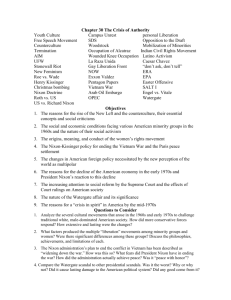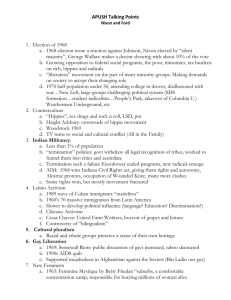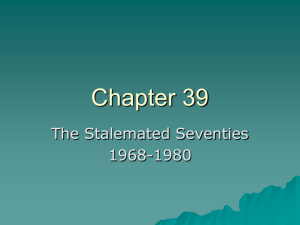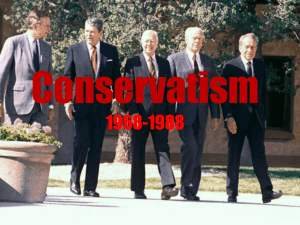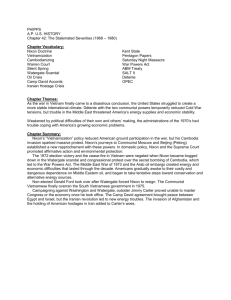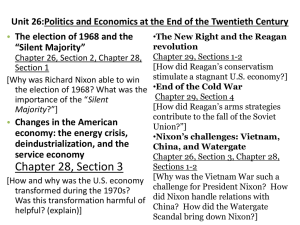New Left, Nixon & Watergate
advertisement
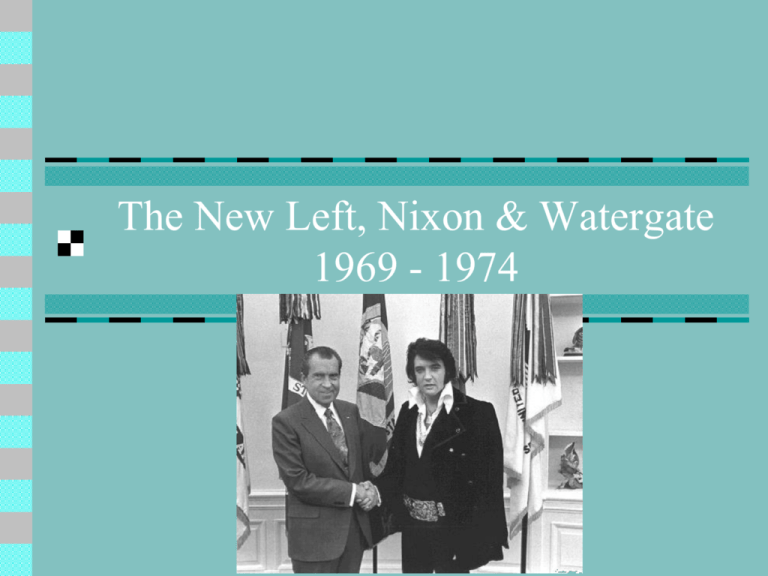
The New Left, Nixon & Watergate 1969 - 1974 The New Left “Old Left” (Socialists & Communists) focused on economic/class issues Primarily concerned with white working class Liberal – Left alliance fell apart after WWII due to Cold War “New Left” focused on group identities & perceived oppression Prosperity enlarged middle class, but highlighted cont. poverty Civil rights movement provided model Students for a Democratic Society (SDS) modeled on SNCC National Organization for Women (NOW) modeled on NAACP American Indian Movement’s (AIM) “Red Power” modeled on “Black Power” Protests & Counterculture Vietnam War came to symbolize all that was wrong with America Showed imperialism, oppression of non-white people, lying by gov’t officials, & use of violence to maintain capitalism ‘teach-ins” began in colleges in spring 1965 60,000 avoided draft by fleeing country 4 students killed by Nat’l Guard at Kent State in May 1968 Political participation by young adults soon fizzled out Counterculture short-lived because nihilistic 26th Amendment (1972) lowered voting age to 18, but few took advantage of it Civil Rights Struggles Continued Battles shifted to de facto segregation In Swann v. Charlotte-Mecklenburg Board of Education (1971) Court ruled busing acceptable to integrate schools Congress responded with 1972 & 1974 Educational Amendments Act: No further than next-nearest school Not if students’ health or education impaired Milliken v. Bradley (1974) – interdistrict busing unacceptable Whites challenged “affirmative action” as reverse discrimination Court ruled in Regents of the Univ. of Cal. v. Bakke (1978) that racial quotas unacceptable in college admissions New (Second Wave) Feminism New feminists pushed for abolition of gender roles & discrimination Betty Friedan published The Feminine Mystique in 1962 National Organization for Women (NOW) founded in 1966 Ms. Magazine began publication in 1972, to counteract magazines like Good Housekeeping Title IX of Educational Amendments Act (1972) mandated equality in athletics funding Abortion Roe v. Wade & Doe v. Bolton (1972) est. legality of abortion as part of a woman’s constitutional right to “privacy” Limits: Only in 1st trimester Once baby can survive outside the womb, state has interest in protecting life Woman’s life and health must also be protected The Equal Rights Amendment Equal Rights Amendment originally proposed in 1923 Passed by Congress in 1972, but never ratified by the states Environmental Movement Rachel Carson warned of dangers of pesticides in Silent Spring (1962) Federal Environmental Protection Agency created in 1970 Clean Air Act (1970) reduced air pollution by 1/3 Occupational Safety & Health Administration (OSHA) reduced workplace hazards First Earth Day celebration was in 1970 Rachel Carson 1968 Presidential Campaign The New Federalism Appealed to “silent majority” frustrated by growing tax burdens Vetoed some spending bills & impounded some funds appropriated by Congress Welfare state continued to grow, nevertheless Budget for social services exceeded defense for 1st time since World War II Supplemental Security Income (1972) increased benefits for elderly, blind & disabled Proposed Family Assistance Plan would’ve guaranteed all families a minimum annual income Stagflation Three causes: Trying to fight War on Poverty & Vietnam War without raising taxes Declining worker productivity & increased competition from Europe & Asia Oil crises in Middle East Nixon’s “New Economic Policy”: Abandoned convertibility of dollars into gold & devalued dollar (ended Bretton Woods system) Slapped 10% surcharge on all imports Temporarily froze wages & prices Détente in Foreign Policy National Security Advisor Henry Kissinger controlled foreign policy Goal of détente: Copyright 2000, Bedford/St. Martin’s play China & USSR off of each other put pressure on North Vietnam to negotiate end to war Nixon visited China in Feb. 1972 – began process of normalizing relations (completed in 1978) Nixon visited Moscow in May 1972 & signed SALT agreements banning ABM systems & limiting ICBMs Watergate Chuck Colson set up team of “plumbers” to fix “leaks” Headed by E. Howard Hunt & G. Gordon Liddy Performed dirty tricks for CREEP James McCord of CREEP spilled beans to Judge Sirica Grand jury & Senate both launched investigations April 1973: Nixon fired Attorney General John Dean & advisors Erlichmann & Haldeman for “cover-up” Watergate May 1973: Archibald Cox appointed special prosecutor Nixon fired Cox for demanding tapes, but new prosecutor, Leon Jaworski, demanded tapes, too Feb. 1974: House committee began impeachment hearings; voted 3 articles of impeachment in July Edited tapes turned over in May; full tapes in August after unanimous Supreme Court ruling Aug. 8, 1974: Nixon resigned Copyright 2000, Bedford/St. Martin’s
